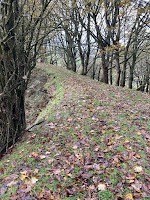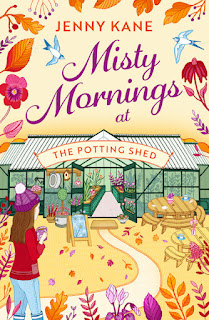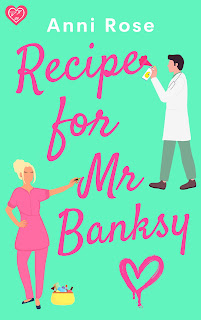Guest Post with Jenny Kane
This week I am delighted to welcome author, Jenny Kane, onto the blog. I'm always in awe of her work ethic and the number of books she has written alongside teaching amazing writing courses and workshops. Her latest novel, Misty Mornings at the Potting Shed, was published by Aria on September 14th.
Jenny, welcome! Can you tell us a bit about your new book?
Misty Mornings at The Potting Shed is the third book in the bestselling, #thepottinghshed
series. It was so much fun going back to The Potting Shed –
a garden centre in Devon - to continue the adventures of sisters, Maddie and Sabi
Willand, and their friends Ed, Jo, and Sara.
After the winter story, Frost Falls at The
Potting Shed, when Maddie and her sister Sabi, take on their late father’s
small plant-growing nursery, and begin to expand it into a garden centre, came
the springtime adventure – Bluebell Season’s at The Potting Shed – when
Jo arrives with his bright orange camper van, full of coffee and cake.
Now,
autumn has arrived, and as with many of my novels, Misty Mornings…
delivers many challenges to the characters within its pages. From the problems
that come with having relatives with dementia, to the practical difficulties of
long-distance relationships, Maddie and the gang must face every day head on if
they want their business to continue to be a success. Here’s little taster from the very beginning of the story…
SEPTEMBER
Flicking a switch, Maddie flooded the garden centre’s shop with light.
‘Sometimes I forget that this used to be the downstairs of my home. Other days I walk in and immediately picture Dad and me sitting on the sofa, right where the houseplant table is.’
Ed smiled at his girlfriend. ‘He’d love it that so many of the locals visit The Potting Shed these days.’
‘He really would.’ A warming glow of satisfaction filled Maddie as she nodded towards the till. ‘Are you okay sorting the shop float if I go and make sure Jo has enough change in the café?’
‘No problem.’ Ed took a pile of five-pound notes from Maddie and flicked them through his fingers.
‘Great. Once we’re open, I’ll man this till until Sabi has finished walking Florrie, then I’ll go and help Jo in the café.’
‘Do you want me to be on carry-to-the-car duty in between watering the polytunnels this morning?’
‘Please.’
‘After that, if it’s quiet, I thought I’d give the bluebell garden a bit of a tidy. It’s not messy as such but…’ Ed pulled a face.
‘It’s gone a bit straggly.’
‘The lack of bluebells doesn’t help either.’
‘Drawback of it being September.’ Maddie plucked a dead leaf off a nearby cyclamen. ‘I considered adding in a few shrubs, but somehow…’
‘You ran out of time?’
‘Don’t I always.’
‘There’s just so much to do.’ Ed grinned. ‘Maybe you should advertise for another member of staff? Sara’s proving a fabulous addition to The Potting Shed, but she only works part-time.’
‘In truth, I could do with that, and another full-time person.’ Maddie dropped the dead leaf into the nearest waste bin. ‘But we aren’t yet that comfortable budget wise.’
‘Sabi still insisting you pay one loan off at a time before you take on another big expense?’
‘Yes, and I’m grateful to her for it. It’s so much less fraught knowing my sister has a grip on the finances. Means I can get on with the gardening and people stuff, without waking up in the middle of the night stressing about bank managers and spreadsheets.’
‘Good job you have me working for free at the weekends then, isn’t it.’
Maddie slipped an arm around Ed’s waist. ‘You can just rest you know; you’ve had a hectic week lawyering. I love that you help here, but I don’t take it for granted. You might want to go walking on Exmoor, or simply put your feet up.’
‘Don’t be silly.’ Ed shook his head. ‘I love it. And it’s a welcome balm after a week in a cut-throat office.’
‘Cut-throat?’ Maddie saw the briefest flash of unease in Ed’s eyes. ‘You’ve never described your new job that way before.’
Ed brushed the comment aside. ‘Maybe cut-throat is a bit much, but the company I work for in Bristol is a very different type of legal business to Ronald’s laid-back old-fashioned solicitors’ office in Exeter. He was very much customer first.’
‘Thank goodness!’...
Thank you, Jenny. That has certainly whetted my appetite to learn more of the story.
Blurb
Don't miss out on the third
lovely book in the brand-new series by #1 Kindle bestselling author Jenny Kane.
Welcome back to The Potting Shed! As
Maddie and Sabi re-open the doors of their family-run garden centre. Business
is booming, and it's time to give back to the community that has kept The
Potting Shed afloat, by opening the Forget-Me-Not dementia café.
But, as the doors to the café open,
Sabi is offered the chance of a lifetime, that could take her away from The
Potting Shed for weeks, café manager Jo's frail, elderly mother is taken ill,
and Maddie's partner, Ed, takes a job in a faraway city just when Maddie needs
him more than ever. A new member of staff is desperately required – who will
join Sara, Jo and Ivan as the busy autumn season fast approaches?
If you would like to read Misty
Mornings at The Potting Shed, it is available from all good retailers,
including:
Amazon UK, Amazon US,
Kobo, Nook and Waterstones as an eBook or
paperback.
You can also preorder the story
in audio format: Amazon UK, Amazon US.
Bio
From the comfort of her cafe corner in Mid
Devon, award-winning author, Jenny Kane, wrote the contemporary women’s fiction
and romance novels, Misty Mornings at The Potting Shed, (Aria, 2023), Bluebell
Season at The Potting Shed, (Aria 2023,), Frost Falls at The Potting
Shed, (Aria, 2022), Winter Fires at
Mill Grange, (Aria, 2021), Spring
Blossoms at Mill Grange, (Aria 2021), Autumn
Leaves at Mill Grange, (Aria, 2020), Midsummer
Dreams at Mill Grange (Aria, 2020), A
Cornish Escape (2nd edition, HeadlineAccent, 2020), A
Cornish Wedding (2nd edition, HeadlineAccent, 2020), Romancing Robin Hood (2nd
edition, Littwitz Press, 2018), Another Glass of Champagne (HeadlineAccent,
2016), and Another Cup of Coffee (HeadlineAccent, 2013).
Jenny has also written 3 novella-length sequels
to her Another Cup of.....books: Another Cup of Christmas (Accent Press,
2013), Christmas in the Cotswolds
(Accent, 2014), and Christmas at the
Castle (Accent, 2016).
Jenny is also the author of quirky children’s
picture books There’s a Cow in the Flat
(Hushpuppy, 2014) and Ben’s Biscuit Tin
(Hushpuppy, 2015).
Under the pen name, Jennifer Ash, Jenny has
also written The Folville Chronicles
(The Outlaw’s Ransom, The Winter Outlaw, Edward’s
Outlaw, Outlaw Justice - published by Littwitz Press, 2016-2020), The Power of Three (Spiteful Puppet,
2020) and The Meeting Place (Spiteful
Puppet, 2019). She has also created several audio scripts for ITV’s popular
1980’s television show, Robin of
Sherwood. (2017 – ongoing)
Jenny Kane is the writer-in-residence for
Tiverton Costa in Devon. She co-runs the creative writing business, Imagine. Jenny teaches a wide range of
creative writing workshops including her popular ‘Novel in a Year’ course. (www.imaginecreativewriting.co.uk)
All of Jennifer Ash’s and Jenny Kane’s news can
be found at www.jennykane.co.uk
@JenAshHistory
@JennyKaneAuthor
@Imagine_Writing
Jennifer Ash https://www.facebook.com/jenniferashhistorical/
Jenny Kane https://www.facebook.com/profile.php?id=100011235488766
Imagine www.imaginecreativewriting.co.uk
As Kay Jaybee (erotica- over 18’s only) you can
find her at www.kayjaybee.me.uk
Thank you for reading. Misty Mornings at the Potting Shed is part of a series. What is it that makes writing and reading a series so popular? I'd love it if you could leave a comment. Thanks.
You may also follow me on:
Twitter/ X - @JanBaynham
Facebook - Jan Baynham Writer
Instagram - janbaynham
To find out more about me and my writing, please visit MY AMAZON PAGE.





















.jpg)
.jpg)


.jpg)





.jpg)
.jpg)









